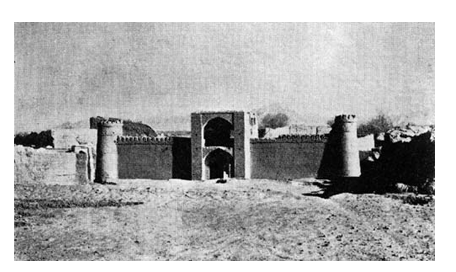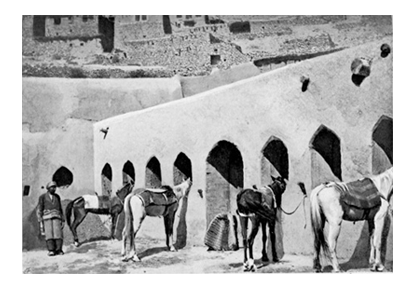 |
The Foundation of Iran's Postal System and the Issue of the First Stamps It is said that the ancient Persians of the Achaemenid Empire were the first who established a well-disciplined system that transported written documents across their vast country. The system was based on courier (or relay) stations (called the Chapar-Khaneh), where a message carrier (called the Chapar) would be assigned with a mail dispatch. He would ride with the mail to the next station, where his horse would be swapped for a fresh one; thus reaching his destination at the shortest possible time. Herodotus praised the Persian couriers by stating: "they are stayed neither by snow nor rain nor heat nor darkness from accomplishing their appointed course with all speed". This verse, though slightly rephrased, prominently features on New York's James Farley Post Office: “Neither snow nor rain nor heat nor gloom of night stays these couriers from the swift completion of their appointed rounds.” During the rule of the subsequent Persian dynasties and also after the Arab conquest, the role of the “Chapars” was vital for the governing authorities. They not only served as couriers to carry decrees and other written messages, but were also expected to act as “eyes and ears” of the state, bringing back the latest news from around the country. |

Maybod Courier Station - One of the few surviving Chapar-khaneh structures |

Chapar-khaneh en-route to Isfahan during the Qajar Period |
At all junctures in the Iranian history, whenever the ruling establishment
attempted to form a system for transporting written messages and documents,
building and maintaining Chapar-Khaneh’s or courier stations was the
essential part of their plan. This courier system, however, was always meant to be exclusive to the ruling elite,
and perhaps some affluent merchants. The general public were
normally not able to enjoy the benefits of the existing Chapar system. For them, private couriers, mostly traveling with slow moving caravans, were the only means of sending and receiving
written messages. The few foreign residents, as well as major merchants
of Tabriz and Tehran dealing with their European counterparts would
confine their correspondence to the couriers of Russian, French, or
British delegations in order to be taken across the border.
Mirza Taghi Khan Farahani renowed as "Amir Kabir" The very first government-organized Chapar system, intended for service to the general public, was initiated in 1851 by the sitting prime minister “Amir Kabir”. It was proclaimed that letters would be dispatched to their destinations at a tariff of 5 Shahi per Misghal (4.6 grams). However, no specific mark showing the fulfillment of payments was applied to the letters. This initiative was abandoned once Amir Kabir's premiership was over. |
 |
 |
Examples of letters dispached through Chapar-khaneh (1854-1856) A few years later, the ruling monarch, Nasser Ed-din Shah was rather fascinated by what his representatives in France had to tell about the Western countries’ achievements in organizing postal services. He was told about the invention of “stamps” that generated large revenues for Western governments. The general public would pay for the “stamps” when their letters and parcels were received by postal offices, and those offices would bear the responsibility for their correct delivery.
The First Stamp Essays of Iran In 1865, Nasser Ed-din Shah commissioned “Amir Nezam”, the head of the Iranian diplomatic mission in Paris, to investigate and undergo negations with French authorities about producing stamps for Iran. Mo’in Al-Molk, the military attaché at the embassy approached the French postal administrators and was subsequently introduced to Albert Barre, the Chief Engraver who had previously designed stamps for France and Greece. Albert Barre received the official order for designing stamps for the Iranian government.
|
At right: Mohammad Hassan Khan (Etemad Al-Saltaneh) - Military attaché at the Persian Embassy in Paris At left: Brig. Mohsin Khan (Mo'in Al-Molk) - Military advisor at the Persian Embassy in Paris |
|
At the same time, a Parisian artist called A. Martin Riester who had heard about the intention of the Iranian mission, offered a design of his own. The mission promised to send his prepared essays to Tehran for approval. Riester’s designs featured a reposing lion with the sun rising on its back, all positioned inside an oval inner frame. His initials “A.R.” appeared below the outer frame. Riester who had not received a reply from the Iranians after a period of 6 month, decided to write directly to Tehran enquiring about his proposed designs. The officials in Tehran, however, returned his essays and strongly protested against the unauthorized printing of stamps that were intended for the government of Iran. |
|||
The essay prepared by Albert Barre |
The essay prepared by Riester |
The design prepared by Albert Barre depicted a standing lion with a sword in its right hand and the sun at its back. Four Farsi figures for the stamp value appeared at the corners of the stamp. Albert Barre also printed a number of partly perforated, gummed essays in sheets of forty stamps. The essay sheets were printed in four different colours: violet, red, blue, and green. In each sheet, stamp values of 1, 2, 4, and 8 were present.
The First Stamps of Iran It is generally accepted that the first stamps of Iran were printed in 1868, in Tehran, and in blocks of four. Four values of 1, 2, 4, and 8 Shahis were said to have been prepared in different colours. However, an alternative school of thought suggests that only the 2 Shahi value was initially printed and offered for postage; trusting that the complete set of four values, known as the Bagheri issue was printed at a later date in 1870. |
Stamps known as the Bagheri issue |
Bagheri stamps were printed in blocks of 4 From the collection of Mr. Joseph Hackmey (Ex. Dr. Dadkhah and Mr. F. N. Farahbakhsh) |
Whatever the truth, it is almost certain that during the first years of their introduction, stamps usage on postal material proved to be very uncommon, to the degree of being almost non-existent. The reasons for the failure in the introductory years could be attributed to several factors, including the lack of adequate directives for the local Chapar officials, and the great famine of 1870-71 which wiped out a quarter of the 6-7 million Iran’s population. |
Mirza Ali Khan Monshi Hozur, "Amin al-Mulk" |
It was about 1872 that Nasser Ed-din Shah attended once again to the dire state of the Chapar system. This time he appointed “Amin Al-Mulk” as the head of the Chapar organization. The new minister set out to bring order to the establishment and issued, for the first time, directives for stamp usage, specifying a tariff of 4 Shahi per Misghal (4.6 grams). Order was sent out that the previously printed Bagheri stamps were to be stuck on the cover of a letter at the time when the clerk accepted it for dispatch. No cancellation marks were applied. |
 |
 |
The following year Amin Al-Mulk decided to resign from his position in order to travel with the Shah to Europe. In 1873, the first official visit of a Qajar ruler to Europe materialized. This trip greatly impressed the Shah who observed firsthand the scientific, technological, administrative, and organizational progress the West had achieved. Upon his stay in Austria, he requested emperor Franz Jozef I to appoint an experienced postal authority in order to help organize a modern postal system in Iran. The emperor suggested Gustav Riederer von Dachsberg, a postmaster with considerable organizational skills. |
 |
||
 |
||
|
Organizing a Modern Postal System for Iran Gustav Riederer arrived in Tehran in early 1875 together with his associates Moriz von Manowarda and Nicola Simons. In the 2-3 years that he was in charge, Riederer succeeded in bringing the primitive state of a corrupt Chapar system up to a modern postal organization, albeit with the unabated support and encouragement of Amin Al-Mulk who was re-instated by the Shah at his former position as the head of the Chapar. In 1875, after having the Barre clichés slightly adapted, Riederer proceeded to print the second set of Iran stamps. For each of the Farsi values, the numerals 1, 2, 4, and 8 were placed under the lion’s body. This move facilitated, for non-Iranians, the representation of each stamp value. The stamps were printed in strips of four and had a quasi-perforation that was probably brought about by means of a roulette tool.
The second issue of the Lion set, also known as the Roulleted Issue bears western numerals below the lion's abdomen Gustav Riederer inaugurated the first regular postal service in Iran in August 1875. The service was between Tehran and Shemiran, serving as a model for the subsequent route between Tehran, Tabriz, and Djulfa on the Russian border. Eventually, other routes and destinations were added to the newly established postal organization. In an article in the UPU periodical "L'Union Postale" in October 1876, Riederer outlined his efforts to the establishment of a modern postal service in Iran. Full transcript of this fascinating article is available here. Riederer’s accomplishments were not only remarkable for laying the foundations of Iran’s modern postal system, but also for his tireless efforts in 1877, in getting Iran admitted as a member to the Universal Postal Union (UPU) despite all the Russian opposition. Iran was among the first 30 nations to join the UPU and as of 1878 all mail to abroad did not need to bear additional Russian or British stamps at the borders.
|
 |
 |
 |
The Architecture of Iran's First Postal Routes
|
 |
 |
1899 Tehran - Post Office at Maydan Toup-khaneh |
1899 Tehran - Post Office Staff References:
|
Novin Farahbakhsh, Stamp Exhibition, Banknote, Farahbakhsh, Stamps, Collection, Stamp Store, Stamps Shop, Philately, Stamp, Stamps of Iran, Iranian Banknote, Iran Stamp, Banknotes of Iran, Stamps Catalogue, Stamps Catalogue of Iran, Banknote Catalogue of Iran, Banknote Catalogue فرح بخش, تمبرفرحبخش، مسعود نوین فرح بخش، تاریخ تمبر، کلکسیون تمبر، مجموعه داری تمبر، اسکناس قدیمی، تمبر قدیمی، تمبر ایران، اسکناس و تمبر پهلوی و جمهوری قاجار، اطلاعات تمبر, راهنمای نگهداری تمبر، راهنمای تمبر، فریدون نوین فرحبخش، تمبر، قيمت تمبر، آلبوم تمبر، کتاب اسکناس، کتاب تمبر، فروش تمبر، خرید تمبر، فروشگاه تمبر، خرید اوراق مصورتمبر، تمبرهای اولیه ایران، آلبوم تمبر، آلبوم اسکناس، خرید اوراق مصور اسکناس، آلبوم سکه، کتاب سکه های ایران، مجموعه کارت پستال های رسمی، کلکسیونرهای برتر تمبرایران، پکیج تمبر، تاریخچه موسسه تمبر نوین فرح بخش، اخبار جدید تمبر، اولین مجله تمبر ایران، اولین نمایشگاه تمبر خاور میانه، تاریخچه انتشار آلبوم و اوراق مصور تمبر، پدر تمبر ایران، تمبر، نوین فرحبخش, نوین فرح بخش، خرید هدیه، سکه، لیوان هایی با تصاویر اسکناس و تمبر